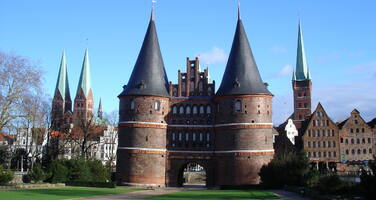Hanseatic City of Lübeck
Factors affecting the property in 1994*
- Deliberate destruction of heritage
- Financial resources
- Housing
- Human resources
- Legal framework
- Management systems/ management plan
Factors* affecting the property identified in previous reports
- Demolition of certain monuments situated in the protected zone
- Mural paintings needing restoration
International Assistance: requests for the property until 1994
Total amount approved : 0 USD
Missions to the property until 1994**
Information presented to the Bureau of the World Heritage Committee in 1994
Lübeck, Germany (C 272rev)
An ICOMOS mission (an urban planner and an urban archaeologist) visited Lubeck in late May 1994, at the request of the municipal authorities, to discuss problems arising from development plans for the city centre. Three main areas of concern were identified, for which possible solutions were proposed.
Investigation of archaeological remains
Lubeck has a rich hidden archaeological heritage, both underground and within standing buildings. Since the end of World War II there has been a series of outstanding urban excavations and the rehabilitation of old buildings has revealed many important features such as wall paintings. These investigations have been possible owing to the relatively slow pace of urban redevelopment in the historic centre. In recent years, however, the pace of this development has increased markedly, with the result that insufficient financial and human resources were available to deal with the flow of planning applications being received.
The mission proposed a revision of the present heritage protection legislation, on the lines of the Areas of Archaeological Importance in Part H of the UK Ancient Monuments and Archaeological Areas Act 1979. This would provide a statutory period before the start of development work during which scientific investigations could be carried out. It was also proposed that the statutory protection of historic buildings should be amended so as to permit the designation of all the buildings within a prescribed conservation area, moving away from the existing piecemeal designation system and the resulting administrative overload.
Presentation of heritage
The mission made proposals for the better display and presentation to the general public of archaeological finds that survive in situ within cellars and elsewhere within the city but which are at present inaccessible. This will heighten the awareness on the part of the inhabitants of Lubeck of the city's rich heritage and assist in improving their attitude towards it.
Development strategy
A conflict was perceived in Ldbeck between heritage conservation and tourist potential on the one hand and a policy for economic growth on the other. The mission stressed the need for the development of an integrated strategy that would permit both objectives to be achieved.
Recommendation
ICOMOS recommends that the authorities in Lubeck be encouraged to revise its heritage protection legislation so as to allow sufficient time for the proper investigation of the city's rich archaeological heritage and to implement measures to make the important archaeological and artistic discoveries accessible to the general public. It also recommends that the authorities should seek the assistance of an experienced international planning consultancy in the preparation of an integrated development strategy which reconciles the competing objectives of heritage conservation, tourism, and economic growth.
Summary of the interventions
Decisions adopted by the Committee in 1994
18 BUR VI.B
Hanseatic City of Lubeck (Germany)
The Bureau was informed of the outcome of an ICOMOS mission which visited Lubeck in May 1994 to discuss problems arising from the development plans for the city centre. The Bureau recommended that the authorities in Lubeck be encouraged to revise its heritage protection legislation so as to allow sufficient time for the proper investigation of the city's rich archaeological heritage and to implement measures to make the important archaeological and artistic discoveries accessible to the general public. It also recommended that the authorities should seek the assistance of an experienced international planning consultancy in the preparation of an integrated development strategy which reconciles the competing objectives of heritage conservation, tourism and economic growth.
* :
The threats indicated are listed in alphabetical order; their order does not constitute a classification according to the importance of their impact on the property.
Furthermore, they are presented irrespective of the type of threat faced by the property, i.e. with specific and proven imminent danger (“ascertained danger”) or with threats which could have deleterious effects on the property’s Outstanding Universal Value (“potential danger”).
** : All mission reports are not always available electronically.


